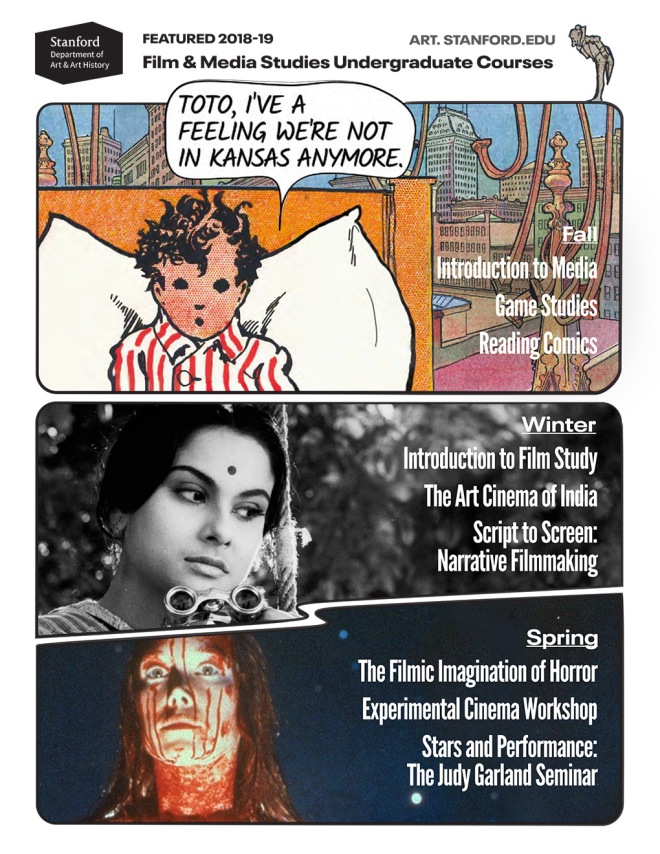
Above, some of the featured undergraduate courses in Stanford’s Film & Media Studies lineup for 2018-2019. A full listing of course offerings can be found here.

Above, some of the featured undergraduate courses in Stanford’s Film & Media Studies lineup for 2018-2019. A full listing of course offerings can be found here.
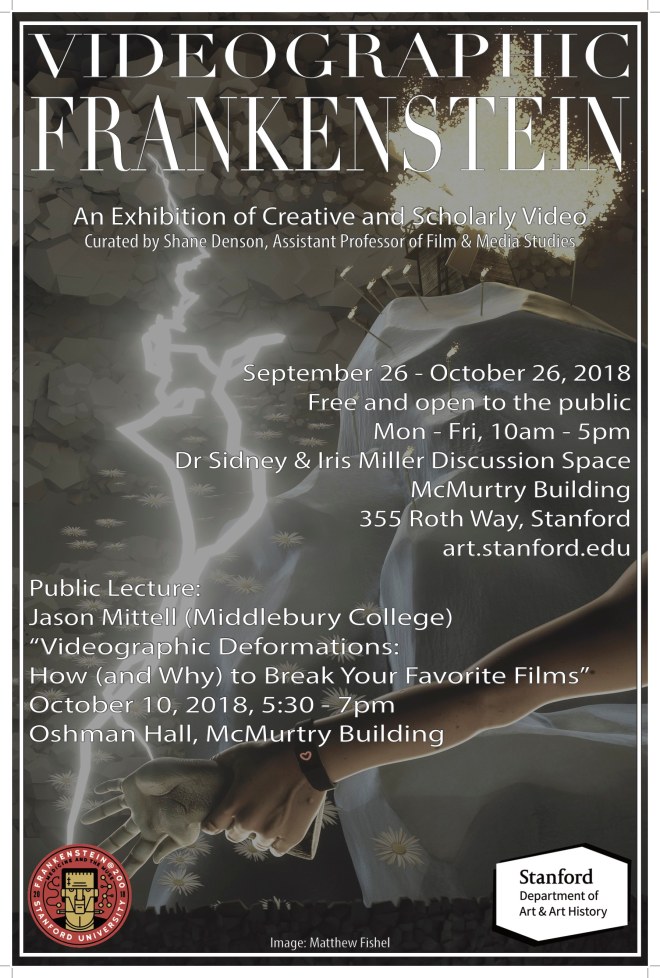
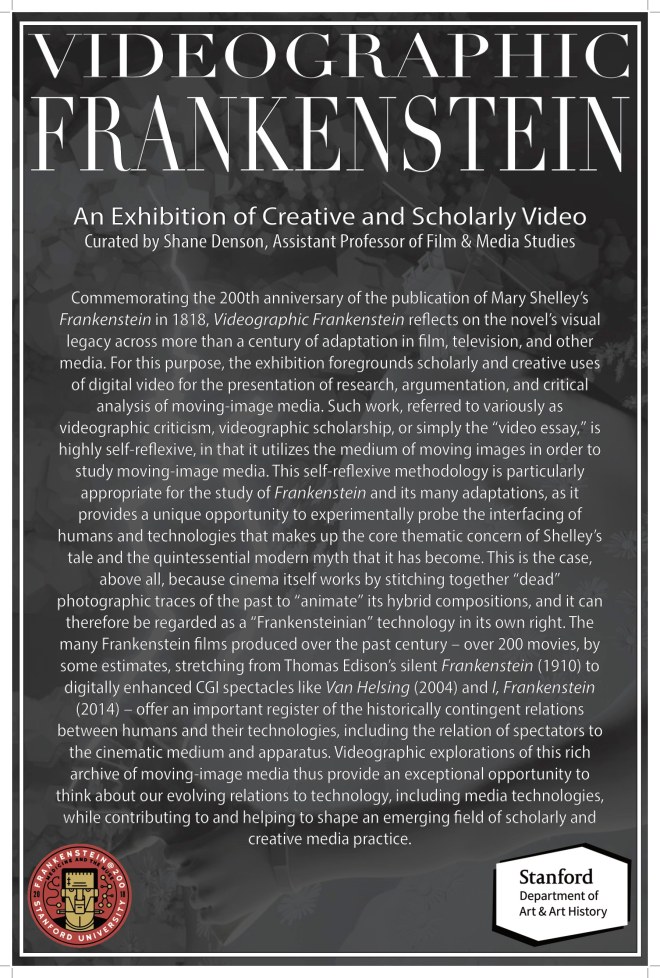
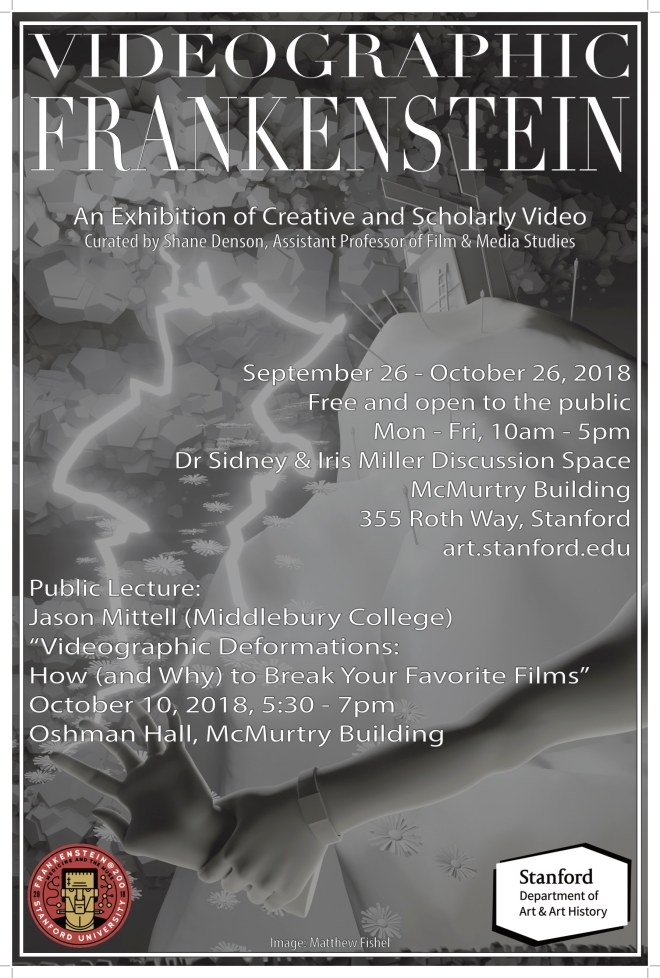

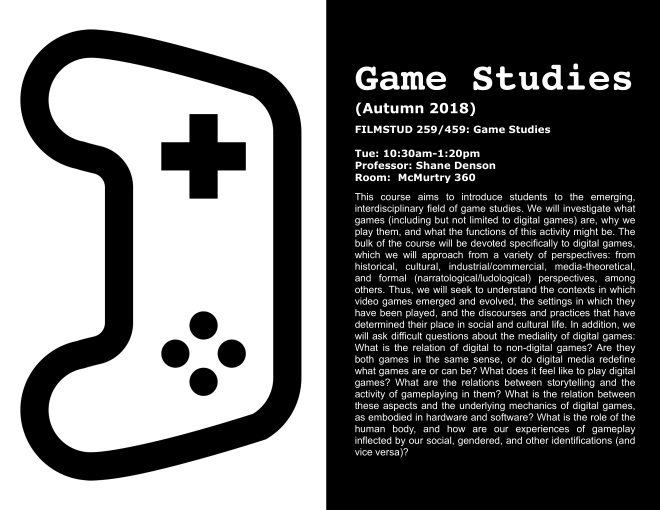
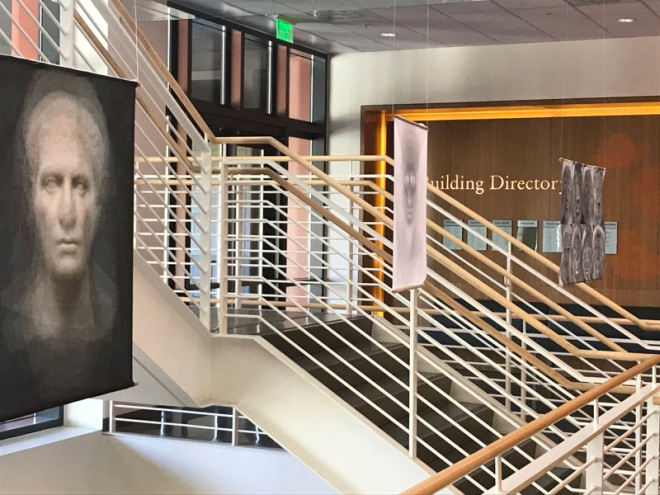
Works from the course “Let’s Make a Monster: Critical Making,” which I co-taught this quarter with my art practice colleague Paul DeMarinis, are currently on display in the Shriram Center for Bioengineering and Chemical Engineering at Stanford University. The show, which officially opened today, is up through Friday, June 8.
We are particularly excited to take this work across campus and show it in the context of a space devoted to cutting-edge engineering work, where we hope that it provokes thought and discussion about the transformations of technology, experience, and life itself taking place in Silicon Valley and elsewhere. Thanks especially to Prof. Drew Endy for his help in facilitating and making this show possible.
Here are just a few glimpses of the work on display.
Nora Wheat, Decode (2018)
Hieu Minh Pham, The Knot (2018)
Raphael Palefsky-Smith, Brick (2018) — more info here
David Zimmerman, Eigenromans I-III (2018)
Jennifer Xilo, Mirror for Our Upturned Palms (2018)
Jackie Langelier, Creepers (2018)
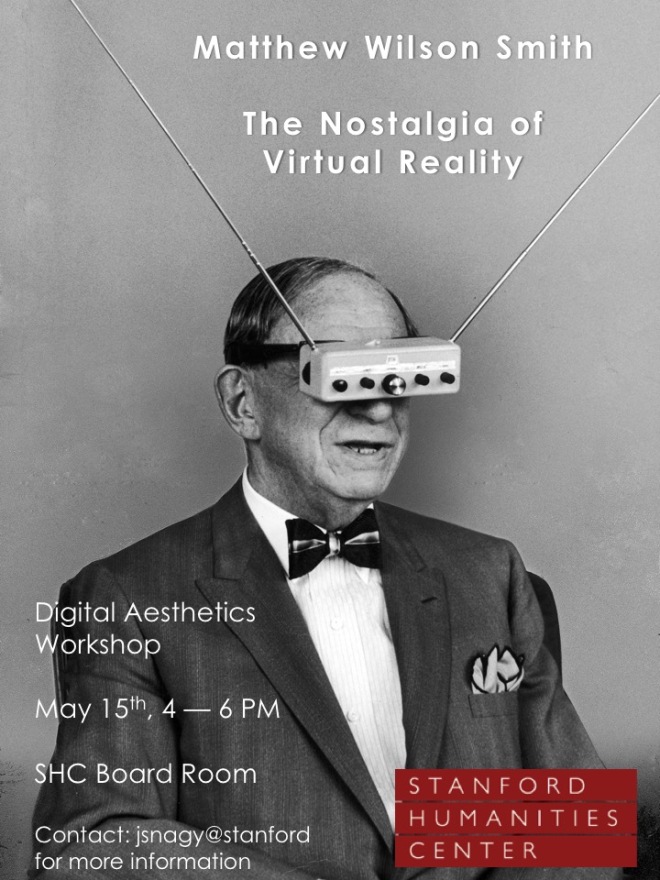
On Tuesday, May 15th, we’ll have our fourth and final Digital Aesthetics Workshop of the Spring quarter, “The Nostalgia of Virtual Reality” with Matthew Wilson Smith, at 4 PM in the Stanford Humanities Center Board Room. In this workshop, we will discuss the degree to which emergent technologies of virtual reality are indebted to longstanding concepts of presence and disembodied consciousness.
Matthew Wilson Smith is an Associate Professor of German Studies and Theatre and Performance Studies at Stanford University. His interests include modern theatre; modernism and media; and relations between technology, science, and the arts. His book The Nervous Stage: 19th-century Neuroscience and the Birth of Modern Theatre explores historical intersections between the performing arts and the neurological sciences and traces the construction of a “neural subject” over the course of the nineteenth century. It was published by Oxford University Press in 2017. His previous book, The Total Work of Art: From Bayreuth to Cyberspace (Routledge, 2007), presents a history and theory of modern artistic synthesis, placing such diverse figures as Wagner, Moholy-Nagy, Brecht, Riefenstahl, Disney, Warhol, and contemporary cyber-artists within a genealogy of totalizing performance.
Somehow I forgot to post the syllabus for “Let’s Make A Monster! Critical Making,” which Paul DeMarinis and I are currently teaching as a hybrid Film & Media Studies and Art Practice class in the Department of Art & Art History at Stanford. The main focus of the course, as the title indicates, is the production of monsters in a variety of media and informed by reading literary, philosophical, and other critical texts on making and monstrosity. Students have been making some truly astounding work, and I look forward to being able to present some of it later in the quarter. We will be organizing an exhibition of works on campus, and I will post images here.

On April 24, 2018 (4-6pm in the Stanford Humanities Center Board Room), Jonathan Sterne will be speaking at the Digital Aesthetics Workshop. The title of his talk is: “Machine Learning, ‘AI,’ and the Politics of Media Aesthetics: Why Online Music Mastering (Sort of) Works.”
Jonathan Sterne is Professor and James McGill Chair in Culture and Technology in the Department of Art History & Communication Studies at McGill University. His work is concerned with the cultural dimensions of communication technologies, especially their form and role in large-scale societies. One of his major ongoing projects has involved developing the history and theory of sound in the modern west. Beyond the work on sound and music, he has published over fifty articles and book chapters that cover a wide range of topics in media history, new media, cultural theory and disability studies. He has also written on the politics of academic labor and maintains an interest in the future of the university. His new projects consider instruments and instrumentalities; histories of signal processing; and the intersections of disability, technology and perception.

The 2018 International Health Humanities Consortium Conference will be held at Stanford University from April 20-22, 2018. The keynote speakers are:
Alexander Nemerov
Professor, Art and Art History at Stanford UniversityLester Friedman
Professor, Media and Society at Hobart and William Smith CollegesAlvan Ikoku
Assistant Professor, Comparative Literature and Medicine at Stanford UniversityCatherine Belling
Associate Professor, Feinberg School of Medicine at Northwestern University
In addition, there will be a number of great events around campus. You can find more information here.
I will be participating in the conference in two ways:
First, on Friday, April 20 (2:30-3:30pm in McMurtry 115) I will be presenting a screening session of videographic works related to “Frankenstein & Film.” I will be showing a few of my own pieces (which you can see here and here), as well as works by video essayists like Allison de Fren, alongside commercial “making of” videos, art film reimaginations, and other moving-image forms that treat the history of Frankenstein films from Thomas Edison’s 1910 production up to the present day.
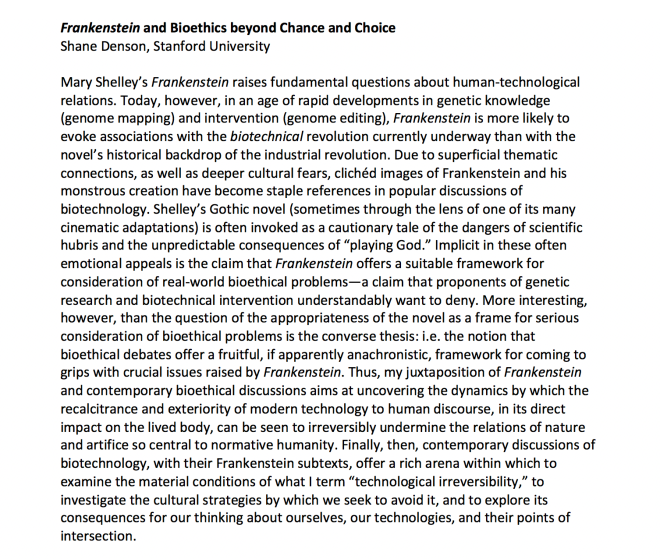
Second, on Sunday, April 22 (11:15am), I will be presenting a paper titled “Frankenstein and Bioethics Beyond Chance and Choice.” The paper draws upon and rethinks ideas that I put forward in one of my very first publications: “Frankenstein, Bioethics, and Technological Irreversibility.” That paper, published in 2007, can be found here.
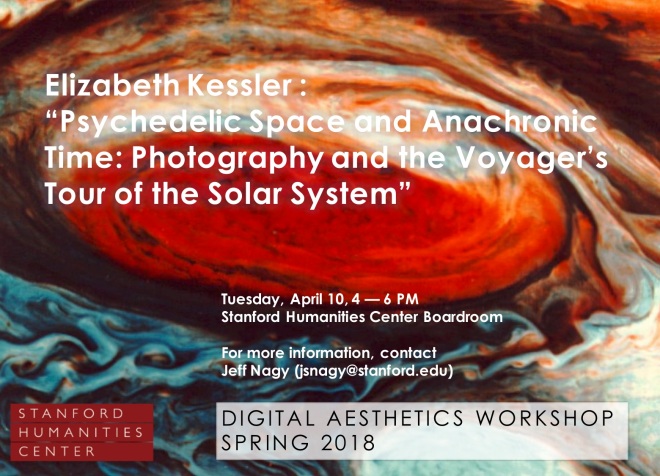
On Tuesday, April 10 (4-6pm in the Board Room of the Stanford Humanities Center), Elizabeth Kessler (Stanford, American Studies) will deliver a talk, titled “Psychedelic Space and Anachronic Time: Photography and the Voyager’s Tour of the Solar System,” in the context of the Digital Aesthetics Workshop.
Elizabeth Kessler’s research and teaching focus on 20th and 21st century American visual culture. Her diverse interests include: the role of aesthetics, visual culture, and media in modern and contemporary science, especially astronomy; the interchange between technology and ways of seeing and representing; the history of photography; and the representation of fashion in different media. Her first book, Picturing the Cosmos: Hubble Space Telescope Images and the Astronomical Sublime, on the aesthetics of deep space images, was published in 2012. She’s currently writing on book on extraterrestrial time capsules, as well as developing a new project on fashion photography.
See here for more information.
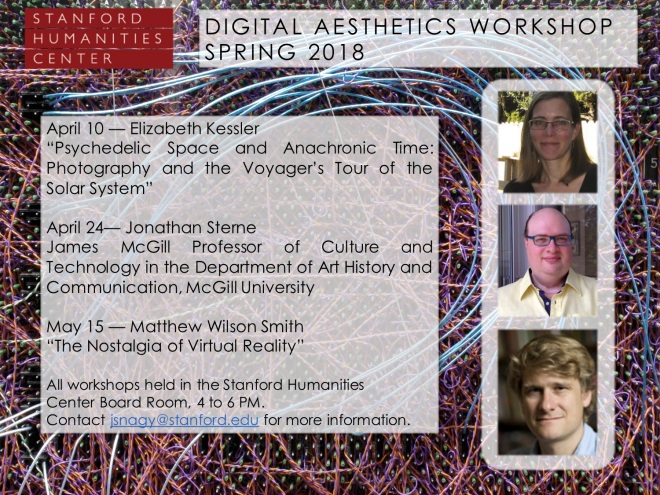
April 10: Elizabeth Kessler
April 24: Jonathan Sterne
May 15: Matthew Wilson Smith
All events held in the Stanford Humanities Center Board Room, 4-6pm.